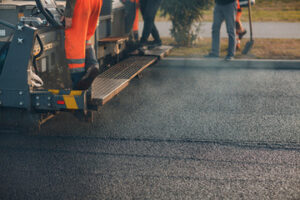Asphalt Paving Charleston SC is a process that involves placing new asphalt on a sturdy sub-base layer. This new layer of asphalt is then rolled to create a smooth surface. After rolling, the new asphalt is left to dry for 24 hours. This drying time depends on the conditions in the area and will vary from one project to another. After 24 hours, the asphalt is ready to drive on. However, it’s important to note that during this time, the new asphalt will turn gray as the sun oxidizes the binder. This process is important because it frees up extra oils in the asphalt binder. The curing process then stops the oxidation process, allowing the asphalt to become ready for use.
Predose is a procedure used to prepare an asphalt pavement for paving. It involves weighing the various components of aggregate in a belt-weighing instrument. The dry aggregate components are then stored in silos, where they are reweighed again. Then, the asphalt binder is added at a controlled rate to the dry aggregate.
The material used for asphalt pavements consists of aggregate with different sizes and shapes. The paving surface has to withstand the weight of the vehicle. This is often measured in ESAL, which stands for equivalent single axle loads. An ESAL of 80 kN is equivalent to approximately 18,000 lb. The aggregate has to resist flexing, which can cause crack initiation.
The asphalt mix is composed of mineral aggregate, asphalt cement, and a diluent. Various methods are used to place this mixture on the paving surface. The mix is usually placed using appropriate hand or mechanical methods. The aggregate size should be at least one sieve size larger than NMAS.
The predose process is the first step in the construction of asphalt pavement. It involves weighing various components and evaluating their weights. These components are then stored in silos and are dried at a temperature of 300 degrees Fahrenheit. Next, the aggregates are spread out evenly on the asphalt surface with the help of spreaders. Aggregate trucks are equipped with hydraulic lifts and spreaders.
HMA Ultra-Thin Asphalt Paving is an innovative surface course that provides a high-performance surface. It consists of a heavy application of polymer-modified asphalt emulsion membrane (PMMAM) over an existing pavement surface. The thick polymer membrane forms a seal that enhances the bonding of the ultra-thin asphalt mix to the existing pavement. It also provides a skid-resistant, durable surface and corrects minor imperfections.
The process of HMA Ultra-Thin Asphalt Paving is a cost-effective way to maintain roads and improve the ride quality for drivers. It also reduces traffic noise. Another application of HMA Ultra-Thin Asphalt Paving is rubblization, which turns a deteriorated concrete road into a base for new pavement. This process reduces delays for motorists and allows construction to take place during non-peak times.
HMA Ultra-Thin Asphalt Paving is an alternative to traditional seals. It restores skid resistance, improves ride quality, eliminates rutting, and reduces life cycle costs. It also provides minimal road user delays while improving structural strength. It is also suitable for use over the existing concrete pavement.
The HMA Ultra-Thin Asphalt Paving process can extend the lifespan of a road by several years. It can also help restore its functionality and reduce traffic noise. In a recent study, Aggregate Industries Northeast Region used a 4.75mm Superpave mixture that contained 30 percent RAP and PG 52-33 binder. The latex added to the mix increases its elasticity and prevents cracking.
The process of HMA Ultra-Thin Asphalt Paving involves a multi-step process. During the process, a new layer of asphalt is applied over the old one. In some cases, HMA Ultra-Thin Asphalt Paving is done on top of existing pavement to restore its function and appearance. In this process, the existing pavement is milled prior to overlaying it with a similar thickness.
Crack and seat techniques for asphalt paving are a cost-effective solution for pavement maintenance. These techniques are used to minimize reflection cracks in the asphalt layer, which are the result of movement between the concrete panels. The process involves cracking and seating concrete slabs to reduce their size and increase flexibility. Seating, in turn, restores support to the cracked portions.
Crack and seat techniques for asphalt paving involve using a heavy roller to “seat” the cracked portion of the roadway. The specification recommends that a roller with a 50-ton capacity be used, but experience has shown that a 20 to 30-ton roller will suffice. Then, the roadway is overlaid with three to five inches of new HMA.
